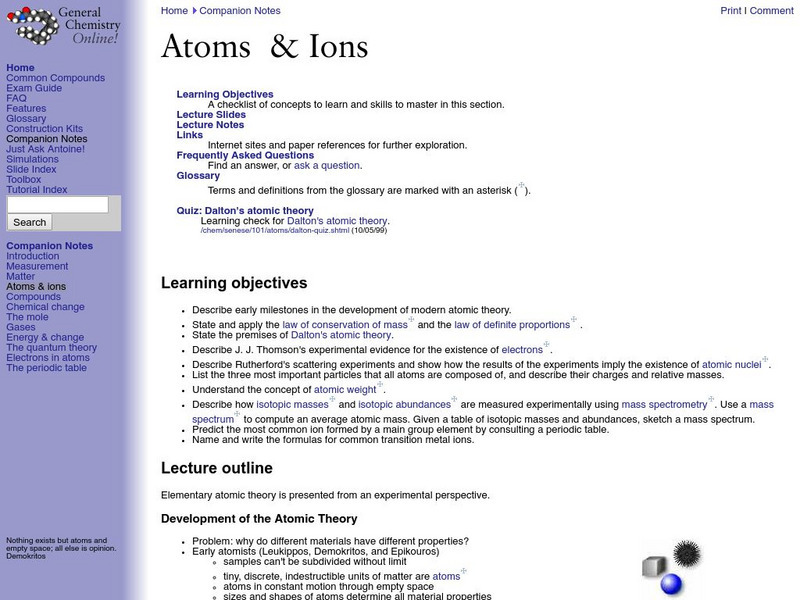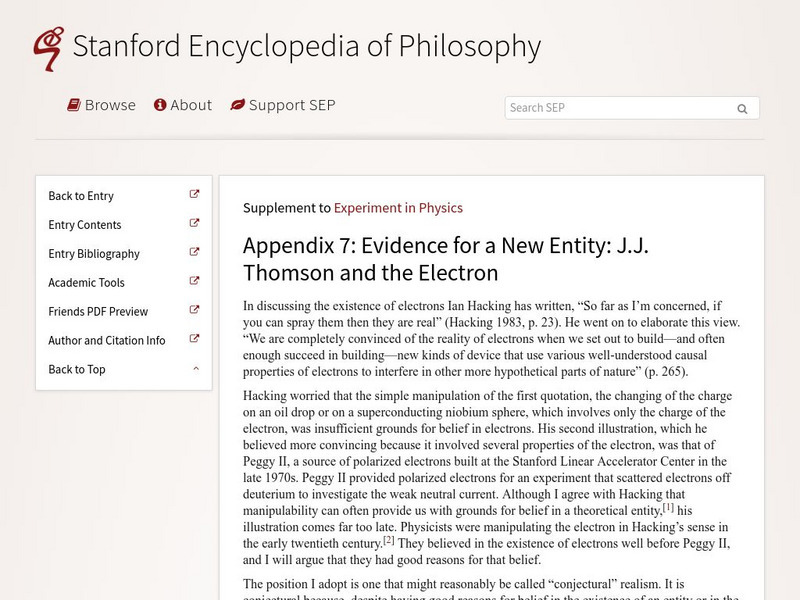Curated OER
Review for Chemistry
In this review for chemistry worksheet, students decide if given statements are true or false. Students relate information learned about introductory knowledge gained in chemistry to accurately answer the given questions.
Other
American Institute of Physics: Discovery of the Electron
Use this resource to read about the "Experiments by J.J. Thomson in 1897 [which] led to the discovery of a fundamental building block of matter." This exhibit is organized into several sections, including: "Mysterious Rays" and "1897...
CK-12 Foundation
Ck 12: The Nuclear Model of the Atom
[Free Registration/Login may be required to access all resource tools.] In the following online tutorial students will distinguish between the three main subatomic particles and understand the contributions of J. J. Thomson, Robert...
CK-12 Foundation
Ck 12: Structure of the Atom
[Free Registration/Login may be required to access all resource tools.] Students learn about the important discoveries of subatomic particles, and how they led to our current understanding of the atom.
Nobel Media AB
The Nobel Prize: The Nobel Prize in Physics 1905
This Nobel E-Museum website commemorates the work of Philipp von Lenard and his Nobel prize achievement. This detailed resource includes a biography, Lenard's Nobel Lecture, and the "The Nobel Prize in Physics 1905 Presentation Speech."
Frostburg State University
General Chemistry Online: Atoms & Ions
This site from the General Chemistry Online of the Frostburg State University provides a review of the history of atomic theory, the discovery of the electron, and the discovery of the nucleus. Details on weighing atoms, ion charges,...
University of Colorado
University of Colorado: Physics 2000: The Big Picture
Ever wondered how your TV produces those images on the screen? You can use the explanations and the interactive applets on these pages to find out how a cathode ray tube allows you to watch your favorite show!
National High Magnetic Field Laboratory
Magnet Academy: Electromagnetic Deflection in a Cathode Ray Tube, Ii
Many people interact with cathode ray tubes for part, if not most, of the day without having a clue how they work. Here's the inside scoop. (Java tutorial)
National High Magnetic Field Laboratory
Magnet Academy: Electromagnetic Deflection in a Cathode Ray Tube, I
Discovering how cathode rays behave in a magnetic field was a big step forward for scientists trying to understand the mysterious phenomenon. (Java tutorial)
Concord Consortium
Concord Consortium: Exploring Electron Properties
Compare cathode ray particles and charged atoms.
Concord Consortium
Concord Consortium: Crookes Tube
Simulating J.J. Thomson's discovery of the electron. Participate in a simulation where two electrodes are connected to a high voltage source and see them produce cathode rays.
Concord Consortium
Concord Consortium: What Are Nature's Building Blocks?
Activity 2 of the module explores: If you can't see it, how do you know it's there? Activities include the concepts of J.J. Thomson, electrons, and the Plum Pudding Model of the Atom.
Simon Fraser University
Chem1 Virtual Textbook: The Quantum Revolution
Acting as a subtopic of the General Chemistry Virtual Textbook's section on Atoms and the Periodic Table, this site discusses the quantum revolution with special attention given to cathode rays and radioactivity.
Other
Fusion Anomoly: William Crookes
A brief biography of Sir William Crookes, the British chemist and physicist who discovered thallium, invented the radiometer, and studied cathode rays. Includes related links.
Stanford University
Stanford Encyclopedia: j.j. Thomson and the Electron
This site from the Stanford Encyclopedia of Philosophy offers a historical review of the discovery of the electron by J. J. Thomson and how he came to his conclusions performing experiments witha cathode ray tube.
Frostburg State University
General Chemistry Online: Discovery of the Electron
This site from General Chemistry Online of the Frostburg State University provides an explanation of Thomson's discovery of the electron using a cathode ray tube and also his plum cake model of the atom.
Wolfram Research
Wolfram Science World: Phillipp Lenard
This site from ScienceWorld mostly describes Lenard's most notable scientific discoveries and contributions. Includes minimal biographical information and links to additional information on related subjects.














